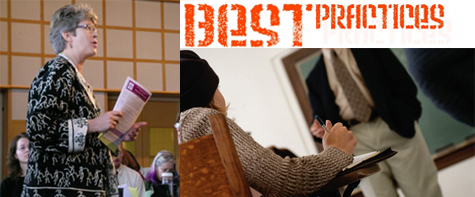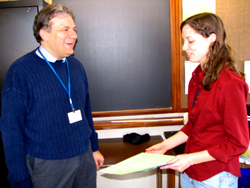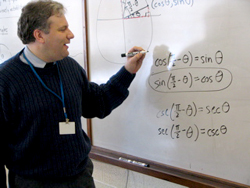
Reflections on what works:
A group of teenage classroom observers raises the bar for teachers
LEXINGTON, MA—For teachers, "being observed" can mean anything from a serious case of the "I'm not good enough!" jitters, to an exhilarating chance to show off a sparkling lesson plan. But it almost never means opening the classroom to a teenager with a clipboard.
At Lexington High School, a large suburban high school outside Boston, a dedicated crew of teenaged students is visiting classrooms with an innovative vision of student-teacher dialogue. They go into classrooms not to learn what is being taught, but to look at how it is being taught, and to create a dialogue about effective teaching and learning.
Ariela Rothstein, a senior, founded the Best Practices Club with ten classmates. They visit classrooms, and meet after school to discuss how people learn. To her, years of being a student in the public school system is the "field work" that prepares young people to give feedback. In 2004, they began to put their experience to the test. They met with supportive teachers, got permission from their principal, and gained the support of the local teachers' union. They developed an observation protocol. Then, they began to observe classes during their off-periods.
"When a teacher really gets it," says Malcolm, a senior jazz pianist, "then they act as if they're being observed everyday. Because they are being observed, by a hundred thinking people."
Finding best practices
 The Best Practices Club only goes into classrooms where they are invited. They aim to forge relationships with teachers that will lead to good conversations and constructive change. To this end, they keep their message positive and highlight what is working rather than what's not. "It's about reflective teaching, not about evaluation. It's not that your job's on the line; it's that we're all reflecting about how learning does happen in the classroom," says Priya, a junior.
The Best Practices Club only goes into classrooms where they are invited. They aim to forge relationships with teachers that will lead to good conversations and constructive change. To this end, they keep their message positive and highlight what is working rather than what's not. "It's about reflective teaching, not about evaluation. It's not that your job's on the line; it's that we're all reflecting about how learning does happen in the classroom," says Priya, a junior.
The word "evaluate" originally meant "assess a tax, or put a strain on," so club members are careful to use the word "observe," rather than evaluate, to describe their work. "When we go into the classroom, we really are looking for the best practices," says Ariela. "They vary according to level. We try to look for best practices that work across the board, in different subjects and levels. One of our major successes has been in bringing teachers from different departments together to learn about what is working in the classroom."
The nuts-and-bolts of the club are fairly simple: individual members visit individual classrooms. They sit in the back and quietly observe the teacher's actions and the responses of their peers as a class unfolds. They look for moments of engagement, and methods that create the most learning. If they see problems, they try to come up with solutions to suggest. Then, they sit down with the teacher to get an understanding of the motivations behind teaching decisions. The student club meets as a group to discuss their observations. Finally, the observing student writes up an analysis and offers it to that teacher, along with a conversation about the learning they saw taking place.
The club has spent a year and a half observing at Lexington, and has seen important change take place in that time: teachers more aware of their methods, and students more empowered to take charge of their educations. At the same time, they are working to share their ideas with educators nationwide. They presented their work in November at the annual meeting of the Coalition of Essential School and in January at a national small schools institute in Florida. This February, Ariela wrote an article for Education Week, urging more students, teachers, and administrators to "find their own way to incorporate a Best Practices-type club into their school."
Rewards for teachers: space for reflection
 Not all faculty members are open to the idea of student feedback about their teaching. "And just where did you get your Ed. D. degree?" is the comeback of a few teachers for whom the idea, understandably, stirs skepticism. But for teachers who have opened the window and welcomed a student observer, the rewards are tangible.
Not all faculty members are open to the idea of student feedback about their teaching. "And just where did you get your Ed. D. degree?" is the comeback of a few teachers for whom the idea, understandably, stirs skepticism. But for teachers who have opened the window and welcomed a student observer, the rewards are tangible.
Many teachers offer an end-of-year evaluation form on which students can give feedback about the class. Yet having a live student observer generates that information before the class concludes. This allows the teacher to make adjustments as he or she goes along.
In the hectic pace of the school day, teachers don't always have the chance to be reflective about what worked and what did not. The club will visit the classroom of any interested teacher. Members feel that their feedback has been most useful with teachers who are neither stars nor patently struggling, but who are in the middle—sometimes effective, sometimes not. The observation visit and ensuing discussion may be the first time all year that these teachers have had a chance to slow down and take a close look at the varying success rates of their different strategies.
Dr. Deborah Johnson is the club's faculty advisor. In her view, the sheer constancy of the teacher-student relationship allows students more insight into teachers' methods than any outside observer could hope to have. "My feeling is that the student has more credentials than any other observer, to assess the teacher," she says. "The student is exposed to the entire curriculum and the ongoing pace of the classroom, the daily differences. Any other observer that comes into the teacher's room is there once, maybe three times in the course of a year. The student, on the other hand, is there every day of the year."
The Best Practices Club gave a presentation to the 150 faculty-members at Lexington High, and afterward, nearly 50 percent of the teachers indicated that they would like to have a student observer come into the classroom.
Student-led professional development is a new idea in education, and it is one whose time, evidently, has come.
Rewards for students: empowered relationships
Students at the affluent campus of Lexington High agree that the culture here is one of competition. The student body is mostly white and Asian, and college acceptance rates are exemplary. In part because of the competitive atmosphere, many students worry that giving feedback to teachers might affect their grades and their futures.
Laura, a senior, says, "Kids are raised to think that the teacher-student relationship should be unequal: 'You're in charge, and I have to be nice to you so I get a good grade.' I think it should be more of a teamwork relationship. You have information, and I'm trying to get that information, and we're trying to reach a point where you can successfully convey that information to me."
The realization that learning is not just a one-way street is one of the tenets of the process. What happens in the classroom is a lot about give-and-take, and relies upon respectful communication from all parties. Laura says, "I can't just critique teachers, because I have to come up with a solution for them. If I can't figure out a solution to a problem with their teaching, then I realize I'm being too critical."
The Best Practices participants are urging students around the country to create venues for this new kind of relationship with teachers. One way to begin is to initiate a "dialogue day," where teachers can ask how students like different teaching methods, and students can ask teachers why they do things in certain ways.
Other ideas that they suggest to schools elsewhere are to create a student-faculty panel on improving teaching and learning at the school; and to develop school-wide protocols that identify which teaching methods are considered Best Practice in that particular learning community.
The students agree that the Best Practices Club has transformed its members.
In addition to gaining skills in public speaking, analysis, and observation, they've planted the seeds of a movement that could affect widely school change—and discovered a new way to participate in the classroom. Malcolm says, "I've become more of an active learner. I've become aware of my responsibility to secure knowledge for myself, and to secure effective teachers and classes for myself. I see that it's my privilege to be educated—not my right. And if I can, I want to have a voice in how it happens."
Click here to read an overview of the Best Practices criteria and two sample class observations.